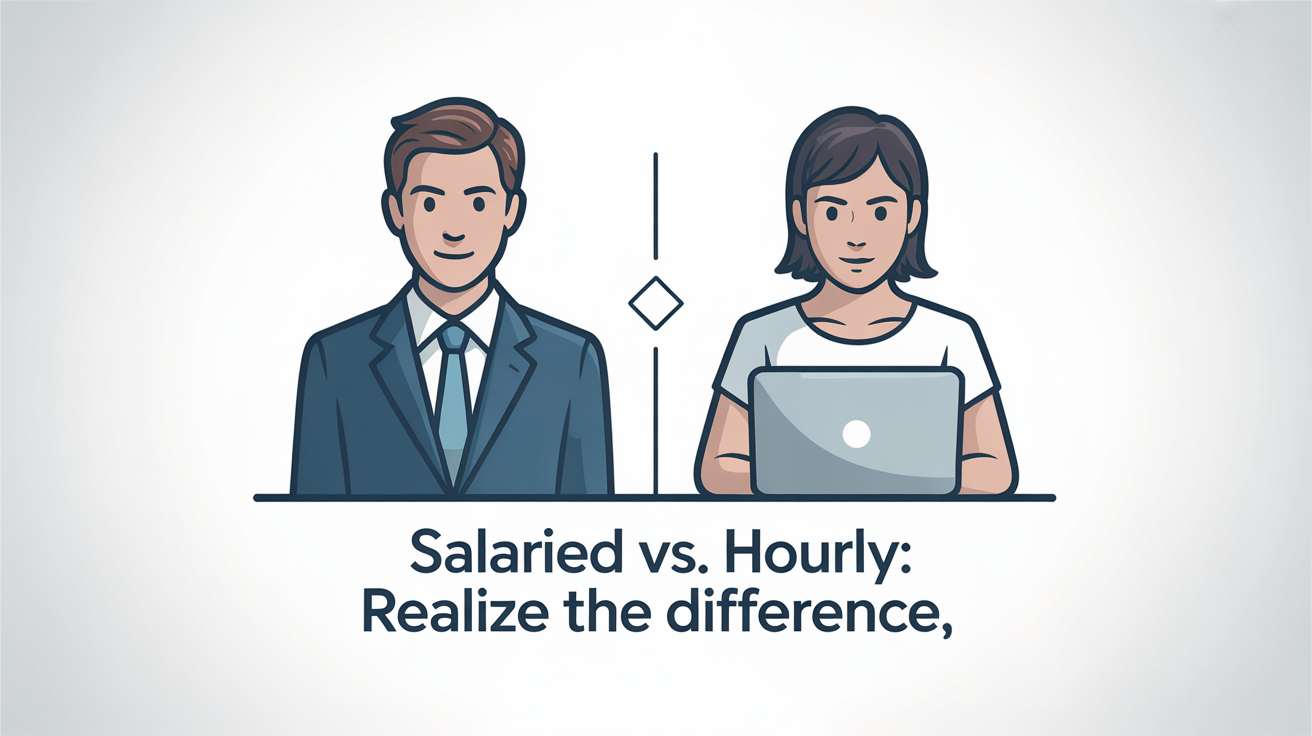
The difference between salaried and hourly employees
In the diverse landscape of employment, understanding the distinctions between salaried and hourly employees is crucial for both employers and employees. These classifications significantly impact an individual’s working conditions, compensation structure, and overall job experience. By grasping these differences, stakeholders can make informed decisions that align with their professional and personal goals.
In this story
Definition of Salaried and Hourly Employees
A salaried employee is typically compensated with a fixed annual amount, divided into regular paychecks, regardless of the actual number of hours worked each week. This type of employment often applies to positions that are classified as “exempt” under the Fair Labor Standards Act (FLSA), meaning these employees are not entitled to overtime pay. Salaried positions are commonly found in professional, managerial, or administrative roles where the focus is on the completion of tasks or goals rather than the hours spent on the job.
In contrast, hourly employees are paid based on the actual hours they work. Their wages are calculated by multiplying the number of hours worked by an agreed-upon hourly rate. These roles are generally classified as “non-exempt” under the FLSA, which means they are eligible for overtime pay—typically one and a half times their regular rate—for hours worked beyond the standard 40-hour workweek. Hourly positions are prevalent in industries such as retail, hospitality, and manufacturing, where work hours can vary significantly from week to week.
Importance of Understanding Employment Types
Understanding the distinctions between salaried and hourly employment is essential for several reasons. For employees, it affects not just their paycheck but also their benefits, job security, and work-life balance. Salaried employees often enjoy more predictable income and may receive additional benefits such as health insurance, retirement plans, and paid time off. However, they may also face expectations to work extra hours without additional compensation, which can impact personal time and stress levels.
Hourly employees, on the other hand, enjoy the flexibility of being compensated for every hour worked, including overtime, which can lead to higher earnings during busy periods. However, they may also experience fluctuations in income due to variable work hours and may not have access to the same level of benefits as their salaried counterparts.
From an employer’s perspective, choosing between salaried and hourly classifications involves considerations of cost management, labor laws, and the nature of the work being performed. Employers must navigate these choices carefully to comply with legal requirements and to foster a motivated and satisfied workforce.
Ultimately, understanding these employment types enables better decision-making and fosters a work environment that aligns with organizational goals and individual needs. By considering the nuances of each classification, both employees and employers can optimize their professional relationships and achieve mutual success.
Characteristics of Salaried Employees
Salaried employees occupy a unique position within the workforce, defined by specific characteristics that influence their compensation, benefits, and work dynamics. Understanding these attributes is essential for both employers and employees to navigate the expectations and advantages associated with salaried roles.
Exempt Status and Benefits
Typically, salaried employees are classified as “exempt” under the Fair Labor Standards Act (FLSA). This classification exempts them from receiving overtime pay for hours worked beyond the standard 40-hour workweek. Exempt status is often associated with roles that require a higher degree of responsibility, decision-making, and specialized skills, such as managerial, professional, or administrative positions. As a result, these employees are expected to complete their tasks regardless of the number of hours required, leading to a focus on results rather than time spent on the job.
In addition to their fixed salaries, exempt employees often enjoy a comprehensive benefits package. These benefits can include health insurance, retirement plans, paid time off, and bonuses. Such packages are designed to attract and retain top talent, providing financial security and incentives that enhance job satisfaction and loyalty. The availability and extent of these benefits can vary significantly between organizations, but they generally form a crucial part of the overall compensation for salaried employees.
Fixed Pay Structure
One of the defining features of salaried employment is a fixed pay structure. Salaried employees receive a predetermined annual salary, distributed in equal installments over the year, which provides consistent and predictable income. This stability is advantageous for personal financial planning, as it ensures that employees receive the same amount each pay period, regardless of the hours worked.
The fixed pay structure reflects a trust-based relationship between the employer and the employee, emphasizing the importance of fulfilling responsibilities over clocking in specific hours. This approach aligns with roles where the value is derived from the quality and impact of work rather than the quantity of time dedicated. However, it also means that salaried employees do not earn additional pay for extra hours worked, which can sometimes lead to extended work hours without additional financial compensation.
Work Expectations and Flexibility
Salaried positions often come with a set of work expectations that differ from hourly roles. These expectations include a higher degree of autonomy and responsibility in managing one’s workload and meeting deadlines. Salaried employees are generally expected to be self-motivated and capable of prioritizing tasks to achieve organizational goals.
While the lack of overtime pay might suggest rigid work demands, salaried roles can offer greater flexibility in how work is completed. Employees might have more leeway in setting their schedules and determining where they work, such as taking advantage of remote or hybrid work arrangements. This flexibility can enhance work-life balance, allowing employees to tailor their work habits to suit personal and professional needs.
In conclusion, the characteristics of salaried employment—exempt status, a fixed pay structure, and flexible work expectations—create a distinct employment model that offers both benefits and challenges. By understanding these traits, employees and employers can better align their goals and expectations, fostering a productive and mutually satisfying work environment.
Characteristics of Hourly Employees
Hourly employees form a vital component of the workforce, characterized by unique employment features that influence their compensation, work schedules, and overall job experience. Understanding these characteristics is crucial for both employers and employees to navigate the expectations and benefits associated with hourly roles.
Non-Exempt Status and Overtime
Hourly employees are typically classified as “non-exempt” under the Fair Labor Standards Act (FLSA). This means they are entitled to overtime pay for any hours worked beyond the standard 40-hour workweek. Overtime is usually compensated at one and a half times the employee’s regular hourly rate, providing an opportunity for increased earnings during busy periods. This classification ensures that employees are fairly compensated for all the hours they work and is particularly common in industries such as retail, hospitality, and manufacturing, where work demands can fluctuate significantly.
The non-exempt status of hourly employees reflects the nature of their roles, which often require adherence to specific work schedules and tasks that are closely supervised. This classification ensures that employees are protected against exploitation and are paid for every hour they contribute to the organization, promoting fairness and transparency in compensation practices.
Variable Pay Based on Hours Worked
A defining characteristic of hourly employment is the variability in pay based on the actual hours worked. Unlike salaried employees who receive a fixed income, hourly employees are paid according to the number of hours they clock in each pay period. This structure provides flexibility in earning potential, allowing employees to increase their income by working additional hours or shifts when available.
However, this variability also introduces a level of unpredictability to an employee’s income. Fluctuations in work hours due to seasonal demand or business needs can lead to inconsistent earnings, making financial planning more challenging. Hourly employees must often balance the desire for additional work with the potential for reduced hours during slower periods, which can affect their overall financial stability.
Scheduling and Work-Life Balance
Hourly employees often contend with varying work schedules, which can impact their work-life balance. Unlike salaried employees who may have more control over their work hours, hourly workers are typically required to adhere to set schedules determined by their employer. This can include working evenings, weekends, or holidays, depending on the needs of the business.
While this structure can present challenges, it also offers opportunities for flexibility. Many hourly positions allow employees to choose shifts or work part-time, accommodating personal commitments such as education, family responsibilities, or other jobs. This flexibility can be particularly beneficial for those who need to balance work with other priorities, providing a degree of control over their time.
In conclusion, the characteristics of hourly employment—non-exempt status with overtime eligibility, variable pay, and structured scheduling—create a unique employment model that offers both opportunities and challenges. By understanding these traits, employees and employers can better align their goals and expectations, fostering a productive and mutually beneficial work environment.
Key Differences
Understanding the key differences between salaried and hourly employees is essential for both workers and employers as these distinctions have significant implications for compensation, legal obligations, and overall employment conditions. These differences shape the work experience and influence decision-making for both parties.
Compensation and Payment Structure
One of the most apparent differences between salaried and hourly employees lies in their compensation and payment structures. Salaried employees receive a fixed annual salary, which is divided into regular payments, providing a consistent and predictable income regardless of the number of hours worked each week. This structure aligns with positions that emphasize the completion of tasks or objectives rather than time spent on specific duties, often involving roles with greater responsibility and decision-making authority.
In contrast, hourly employees are compensated based on the actual number of hours they work, with their earnings calculated by multiplying hours worked by an hourly rate. This structure provides more flexibility in earning potential, with the opportunity to earn overtime pay for hours worked beyond the standard 40-hour workweek. However, it also introduces variability in income, as paychecks can fluctuate based on work hours, affecting financial stability and planning.
Legal and Regulatory Aspects
The legal and regulatory aspects governing salaried and hourly employees also differ significantly. Salaried employees are typically classified as “exempt” under the Fair Labor Standards Act (FLSA), meaning they are not entitled to overtime pay. This classification is associated with roles that involve executive, administrative, or professional duties, where employees are expected to manage their time to meet job responsibilities.
Hourly employees, on the other hand, are classified as “non-exempt” under the FLSA, making them eligible for overtime pay. This classification ensures that hourly workers receive fair compensation for all hours worked, protecting them from being overworked without additional pay. Employers must carefully adhere to these classifications to comply with labor laws and avoid potential legal issues related to wage and hour disputes.
Impact on Job Security and Benefits
The differences in compensation and legal status between salaried and hourly employees extend to job security and benefits. Salaried employees often enjoy greater job security, as their roles typically involve long-term strategic responsibilities that require continuity and expertise. They also tend to receive more comprehensive benefits packages, including health insurance, retirement plans, and paid time off, which are designed to attract and retain skilled professionals.
Hourly employees, while benefiting from the flexibility of variable hours and overtime pay, may face less job security, particularly in industries with fluctuating demand. Their access to benefits may be more limited or contingent on meeting certain eligibility criteria, such as a minimum number of hours worked per week. This can affect their overall job satisfaction and long-term career stability.
In conclusion, the distinctions between salaried and hourly employees encompass various aspects of employment, from compensation and legal classifications to job security and benefits. By understanding these key differences, both employers and employees can make informed decisions that align with their strategic goals and personal needs, fostering a work environment that supports mutual success and satisfaction.
Pros and Cons of Each Employment Type
When choosing between salaried and hourly employment, it’s crucial to understand the advantages and disadvantages each type offers. These aspects affect not only the financial and legal aspects of employment but also work-life balance and job satisfaction.
Advantages and Disadvantages of Salaried Positions
Salaried positions offer several appealing benefits, primarily centered around financial stability and comprehensive benefits. With a fixed annual salary, employees benefit from a predictable income, which facilitates personal financial planning and stability. This consistency is particularly advantageous for those with ongoing financial commitments, such as mortgages or family expenses. Additionally, salaried positions often come with more extensive benefits packages, including health insurance, retirement plans, and paid leave, which enhance job satisfaction and security.
However, salaried roles also have their drawbacks. One significant disadvantage is the expectation to work beyond standard hours without additional pay, as salaried employees are typically exempt from overtime. This can lead to work-life imbalances, especially in roles with high demands and responsibilities. The pressure to meet organizational goals can result in extended hours and increased stress, impacting personal time and well-being. Moreover, while salaried positions often involve greater responsibility and autonomy, they may also come with higher expectations for performance and results, which can be challenging for some individuals.
Advantages and Disadvantages of Hourly Positions
Hourly employment offers flexibility that can be particularly attractive to those seeking adaptable work arrangements. One of the primary benefits is the ability to earn overtime pay for hours worked beyond the typical 40-hour workweek, providing opportunities for increased earnings during peak periods. This pay structure ensures fair compensation for all hours worked, promoting transparency and fairness. Additionally, hourly positions can offer flexibility in scheduling, allowing employees to balance work with personal commitments such as education, family, or other interests.
Despite these advantages, hourly positions also present certain challenges. The variability in work hours can lead to unpredictable income, making financial planning more difficult. This uncertainty can be particularly challenging in industries with seasonal fluctuations or inconsistent demand. Furthermore, hourly employees may have limited access to benefits compared to their salaried counterparts, affecting their long-term job satisfaction and financial security. The requirement to adhere to specific schedules can also restrict flexibility, impacting the ability to balance work with personal needs.
Both salaried and hourly employment types have their unique advantages and disadvantages, influencing various aspects of work life. By understanding these pros and cons, individuals can make informed decisions that align with their personal and professional goals while employers can tailor their workforce strategies to meet organizational needs effectively.
Conclusion
Navigating the complexities of employment types is crucial for both employers and employees, as the choice between salaried and hourly positions significantly impacts compensation, job satisfaction, and organizational dynamics. Understanding these distinctions helps in making informed employment decisions and aligning professional goals with personal needs.
Summary of Key Points
Throughout our exploration of salaried and hourly employment, several key differences have emerged. Salaried employees benefit from a fixed annual income, providing financial predictability and access to comprehensive benefits packages. These roles, often exempt from overtime, come with expectations of task completion rather than time tracking, which can lead to extended work hours without additional compensation. In contrast, hourly employees are compensated based on actual hours worked, with eligibility for overtime pay, ensuring fair compensation for all hours. This structure offers flexibility but can lead to variable income and potentially fewer benefits.
Legal and regulatory frameworks distinguish between exempt and non-exempt roles, influencing compensation and work expectations. Salaried positions often entail greater responsibility and are aligned with strategic goals, while hourly roles prioritize compliance with labor laws, ensuring fair treatment and pay.
Considerations for Employers and Employees
For employers, understanding the implications of each employment type is essential in building a workforce that aligns with organizational goals. Deciding between salaried and hourly classifications involves assessing the nature of the work, the level of responsibility, and compliance with legal standards. Employers should consider how these classifications impact employee motivation, satisfaction, and retention. Offering competitive compensation and benefits, regardless of employment type, can enhance job satisfaction and foster a positive work environment.
Employees, on the other hand, must weigh the pros and cons of each employment type in relation to their personal and career goals. Salaried positions may appeal to those seeking stability and long-term growth, while hourly roles might suit individuals who value flexibility and the opportunity to earn overtime. Understanding how these choices affect work-life balance, financial planning, and career development is crucial in making informed decisions.
In conclusion, the distinction between salaried and hourly employees is fundamental to the employment landscape, influencing legal, financial, and personal dimensions of work. By recognizing these differences and considering the implications for both employers and employees, stakeholders can create a work environment that is both productive and fulfilling, ultimately leading to mutual success and satisfaction.




Leave a Reply